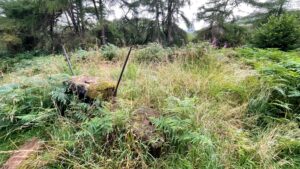A morning with the National Trust, cutting back the summer growth from around the brick and stone remains known as the Kip, at the Cliff Rigg end of Newton Wood.
The Kip is the remains of the head of a narrow-gauge tramway incline. Ore from Roseberry Ironstone Mine once hurtled down here under its own weight to the North Eastern Railway sidings, where it was transferred into standard gauge wagons bound for the furnaces of Teesside.

My task was centred on the nearby drum house, thirty metres away and slightly higher up the slope. Here, a great drum wound with steel cable once linked six full wagons with six empties. As the loaded wagons descended, the empties were hauled up, the drum keeping their speed in check. At the top, the empties rolled over the Kip into a siding in a cutting called the dish, where they were held while uncoupled. The incline, one in five and 350 metres long, was only part of the journey. From here, a stationary steam engine by the mine entrance off Aireyholme Lane pulled the empties up a gentler slope, while the full wagons trundled down by gravity. The tramway ran from 1907 to 1931, though mining ceased in 1926.
Clearing the site is considered necessary for preserving this industrial archaeology. Without the tangle of bracken and grass, the structure’s form is clear again. Yet it does prompt thought. Over time, fallen leaves and rotting plants create humus, steadily burying whatever lies beneath. Are we simply delaying that process? The lowest sandstone blocks already lie under a thick coat of moss. Might that moss in fact be protecting them from the weather rather than harming them?
This is not an argument against clearing. Roots, if left unchecked, can certainly undermine the structure. It is merely an observation.

Leave a Reply